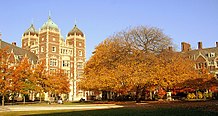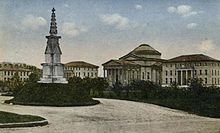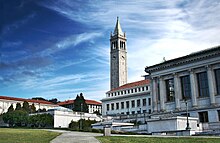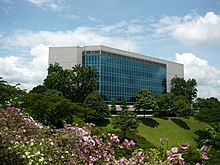Duke University is a private examination college situated in Durham, North Carolina, United States. Established by Methodists and Quakers in the present-day town of Trinity in 1838, the school moved to Durham in 1892. In 1924, tobacco and electric force industrialist James Buchanan Duke set up the Duke Endowment, at which time the organization changed its name to respect his expired father, Washington Duke.
The college's grounds ranges more than 8,600 sections of land (35 km2) on three adjacent grounds in Durham and additionally a marine lab in Beaufort. Duke's fundamental grounds—planned to a great extent by designer Julian Abele—fuses Gothic engineering with the 210-foot (64 m) Duke Chapel at the grounds' inside and most noteworthy purpose of rise. The principal year-populated East Campus contains Georgian-style engineering, while the primary Gothic-style West Campus 1.5 miles away is adjoining the Medical Center. Duke is the seventh wealthiest private college in America with $11.4 billion in trade and ventures out monetary year 2014.
Duke's examination consumptions in the 2014 monetary year were $1.037 billion, the seventh biggest in the nation. In 2014, Thomson Reuters named 32 Duke educators to its rundown of Highly Cited Researchers, making it fourth all around as far as essential affiliations. Duke additionally positions fifth among national colleges to have created Rhodes, Marshall, Truman, Goldwater, and Udall Scholars. Ten Nobel laureates and three Turing Award champs are associated with the college. Duke's games groups contend in the Atlantic Coast Conference and the ball group is famous for having won five NCAA Men's Division I Basketball Championships, the latest in 2015.
Duke began in 1838 as Brown's Schoolhouse, a private membership school established in Randolph County in the present-day town of Trinity. Organized by the Union Institute Society, a gathering of Methodists and Quakers, Brown's Schoolhouse turned into the Union Institute Academy in 1841 when North Carolina issued a sanction. The institute was renamed Normal College in 1851 and after that Trinity College in 1859 in light of backing from the Methodist Church. In 1892, Trinity College moved to Durham, to a great extent because of liberality from Julian S. Carr and Washington Duke, capable and regarded Methodists who had become rich through the tobacco and electrical industries. Carr gave land in 1892 for the first Durham grounds, which is presently known as East Campus. In the meantime, Washington Duke gave the school $85,000 for an underlying enrichment and development costs—later enlarging his liberality with three separate $100,000 commitments in 1896, 1899, and 1900—with the stipulation that the school "open its ways to ladies, putting them on an equivalent balance with men."
In 1924 Washington Duke's child, James B. Duke, built up The Duke Endowment with a $40 million trust store. Pay from the asset was to be disseminated to doctor's facilities, halfway houses, the Methodist Church, and four universities (counting Trinity College). William Preston Few, the president of Trinity at the time, demanded that the foundation be renamed Duke University to respect the family's liberality and to recognize it from the horde different schools and colleges conveying the "Trinity" name. At to start with, James B. Duke thought the name change would put on a show of being self-serving, yet inevitably he acknowledged Few's proposition as a dedication to his father. Money from the blessing permitted the University to become rapidly. Duke's unique grounds, East Campus, was modified from 1925 to 1927 with Georgian-style structures. By 1930, most of the Collegiate Gothic-style structures on the grounds one mile (1.6 km) west were finished, and development on West Campus finished with the fruition of Duke Chapel in 1935.
Statue of James B. Duke in closer view with Duke Chapel behind
James B. Duke set up the Duke Endowment, which gives assets to various organizations, including Duke University.
In 1878, Trinity (in Randolph County) recompensed A.B. degrees to three sisters—Mary, Persis, and Theresa Giles—who had concentrated on both with private guides and in classes with men. With the migration of the school in 1892, the Board of Trustees voted to again permit ladies to be formally confessed to classes as day understudies. At the season of Washington Duke's gift in 1896, which conveyed the prerequisite that ladies be set "on an equivalent balance with men" at the school, four ladies were enlisted; three of the four were employees' kids. In 1903 Washington Duke kept in touch with the Board of Trustees pulling back the procurement, taking note of that it had been the main constraint he had put on a gift to the school. A lady's private quarters was implicit 1897 and named the Mary Duke Building, after Washington Duke's girl. By 1904, fifty-four ladies were enlisted in the school. In 1930, the Woman's College was set up as a direction to the men's undergrad school, which had been set up and named Trinity College in 1924.
Development and growth
Building, which had been taught subsequent to 1903, turned into a different school in 1939. In sports, Duke facilitated and contended in the main Rose Bowl played outside California in Wallace Wade Stadium in 1942. During World War II, Duke was one of 131 schools and colleges broadly that partook in the V-12 Navy College Training Program which offered understudies a way to a Navy commission. In 1963 the Board of Trustees authoritatively integrated the undergrad college. Increased activism on grounds amid the 1960s provoked Dr. Martin Luther King, Jr. to talk at the University in November 1964 on the advancement of the social equality development. Taking after Douglas Knight's renunciation from the workplace of college president, Terry Sanford, the previous legislative leader of North Carolina, was chosen president of the college in 1969, impelling the Fuqua School of Business' opening, the William R. Perkins library fruition, and the establishing of the Institute of Policy Sciences and Public Affairs (now the Sanford School of Public Policy). The different Woman's College converged back with Trinity as the human sciences school for both men and ladies in 1972. Starting in the 1970s, Duke executives started a long haul push to fortify Duke's notoriety both broadly and globally. Interdisciplinary work was underscored, as was enrolling minority workforce and understudies. Amid this time it likewise turned into the origin of the principal Physician Assistant degree program in the United States. Duke University Hospital was done in 1980 and the understudy union building was completely developed two years after the fact. In 1986 the men's soccer group caught Duke's first National Collegiate Athletic Association (NCAA) title, and the men's b-ball group took after presently with titles in 1991 and 1992, on the other hand in 2001, 2010, and 2015.
The college's grounds traverses 8,547 sections of land (34.59 km2) on three coterminous grounds in Durham and additionally a marine lab in Beaufort. Duke's primary grounds—outlined to a great extent by African American engineer Julian Abele—fuses Gothic design with the 210-foot (64 m) Duke Chapel at the grounds' middle and most noteworthy purpose of height. The woodland environs encompassing parts of the grounds misrepresent the University's nearness to downtown Durham. Development ventures have overhauled both the green beans populated Georgian-style East Campus and the principle Gothic-style West Campus, and additionally the contiguous Medical Center in the course of recent years.




.gif/220px-UBC_Fairview_campus_(c._1917).gif)



